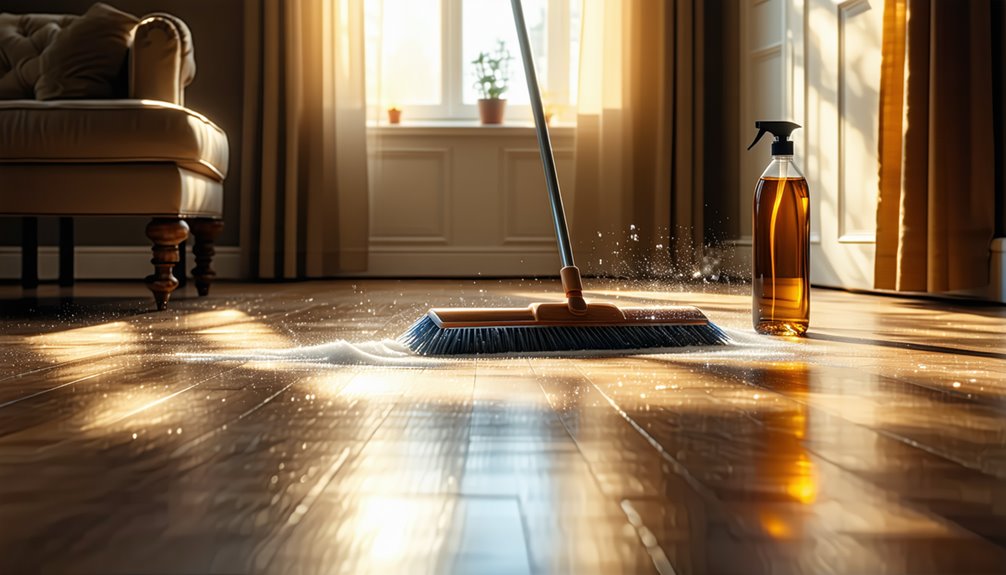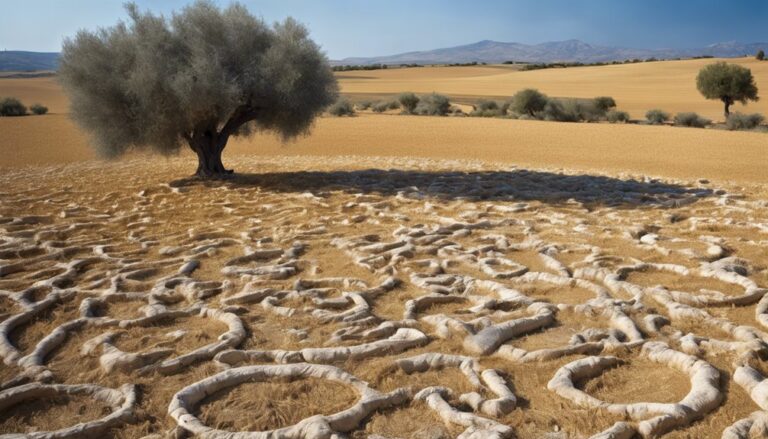To polish your wood floors, start by inspecting for scratches and wear, addressing any issues before you proceed. Remove furniture and clean thoroughly with a soft broom and vacuum, using a pH-balanced wood cleaner. Choose a high-quality polish that matches your floor's finish, and apply it using a clean mop in smooth strokes to prevent streaks. Buff the floor with a floor buffer for an even shine, working in sections. Allow adequate drying time, maintaining good air circulation. Regular maintenance will keep your floors looking great, and you'll discover effective tips for long-lasting shine as you continue exploring!
Assessing Floor Condition
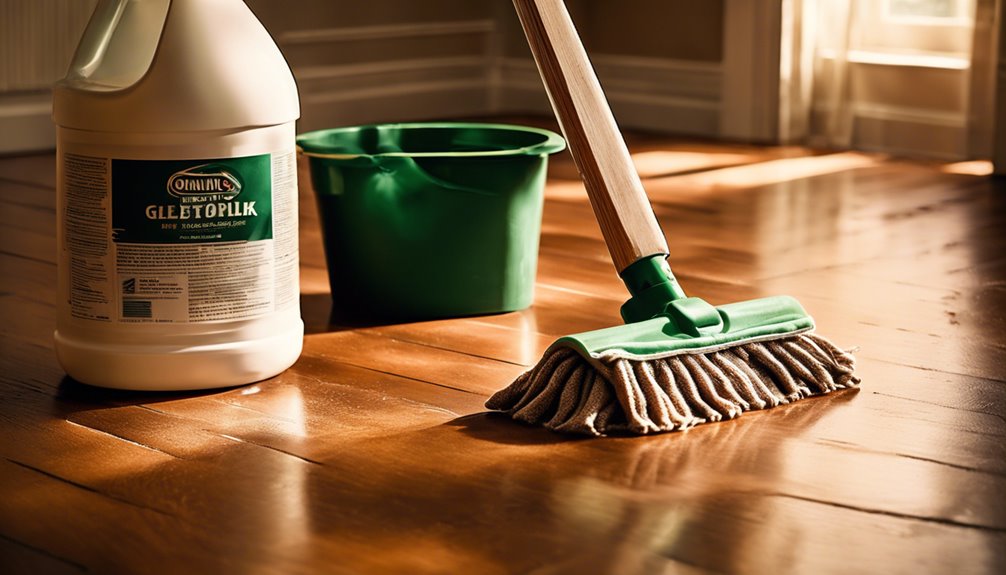
Before you plunge into polishing your wood floors, it's essential to assess their condition. Start with a thorough floor inspection, checking for scratches, dents, or discoloration. Look closely at the seams and edges, as these areas often show wear first. A damage assessment will help you determine if there are deeper issues, like warping or water damage, that need addressing before polishing. Don't forget to check for loose boards or squeaks, as these can affect the finish. By identifying problem areas now, you can avoid costly repairs later and achieve a smoother, more even polish. Remember, your freedom to enjoy beautiful floors starts with a solid foundation, so take the time to verify everything's in top shape.
Choosing the Right Products
Choosing the right products for polishing your wood floors can make all the difference in achieving a beautiful finish. Start by considering the product types that suit your floor's finish—whether it's oil-based or water-based. For oil-based finishes, use a high-quality polish designed for that specific type. Water-based products are great for a more eco-friendly option and offer a quick-drying solution. Next, think about application methods; you can use a mop for even coverage or a buffing machine for a professional look. Always check the manufacturer's recommendations to verify compatibility. With the right products and techniques, you'll not only enhance the appearance of your floors but also protect them from wear and tear, giving you the freedom to enjoy your space.
Preparing the Area
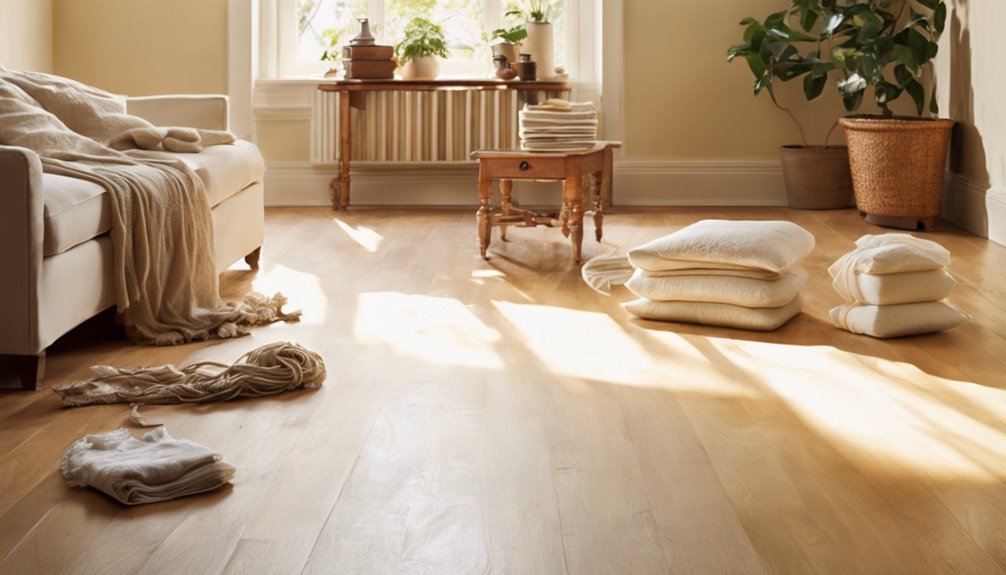
After selecting the right polish for your wood floors, it's time to get your space ready for the job. Start by removing all furniture from the area; this guarantees you polish every inch without obstruction. If moving heavy items isn't an option, consider using furniture sliders to make it easier.
Next, protect your baseboards and any adjacent surfaces with painter's tape. This helps prevent any accidental polish spills from marring your walls or trim.
Here's a quick reference table to help you:
| Task | Purpose |
|---|---|
| Furniture Removal | Clear workspace |
| Area Protection | Safeguard surfaces |
| Gather Supplies | Verify readiness |
With your area prepped, you're all set to start polishing!
Cleaning the Floors
Before you start polishing, it's crucial to clean your wood floors thoroughly. Gather your cleaning supplies, including a broom, vacuum, and a suitable wood floor cleaner. Once you've got everything ready, sweep and vacuum to remove dirt and debris, ensuring a smooth surface for polishing.
Gather Cleaning Supplies
When it comes to gathering cleaning supplies for polishing your wood floors, having the right tools on hand is crucial. You'll need a few key items to guarantee a successful and efficient process. Here's a quick reference table to help you out:
| Cleaning Tool | Purpose | Essential Supplies |
|---|---|---|
| Soft-bristle broom | Dust and debris removal | Broom |
| Vacuum cleaner | Deep cleaning | Vacuum with hardwood setting |
| Microfiber mop | Applying polish | Reusable mop pads |
| Wood floor cleaner | Cleaning solution | pH-balanced cleaner |
| Polishing pad | Buffing the floor | Compatible with polish |
Make sure you gather these cleaning tools to create a smooth and shiny finish on your beautiful wood floors.
Sweep and Vacuum
To achieve a clean surface for polishing your wood floors, start by thoroughly sweeping and vacuuming the area. Use effective sweeping techniques, like pushing debris toward a corner or using a microfiber broom that captures dust efficiently. This will help gather loose particles before you vacuum. When it comes to vacuuming, opt for vacuum types designed specifically for hardwood floors; these usually have soft bristles or a hard floor setting to prevent scratches. Make sure to vacuum in the direction of the wood grain to avoid damaging the surface. Don't forget to get into corners and under furniture, ensuring you remove all dirt and dust. A clean floor is essential for a successful polish, so take your time with this step!
Use Appropriate Cleaner
Choosing the right cleaner is essential for maintaining the beauty and longevity of your wood floors. Avoid harsh chemicals that can damage your finish. Instead, look for eco-friendly cleaners and pH balanced solutions that are safe for both your floors and the environment. Here are some tips for selecting the best cleaner:
- Opt for products specifically designed for wood floors.
- Check for biodegradable ingredients to minimize environmental impact.
- Verify the cleaner is free from wax or silicone, which can leave residue.
- Test any new cleaner in a small, inconspicuous area first.
Testing the Polish
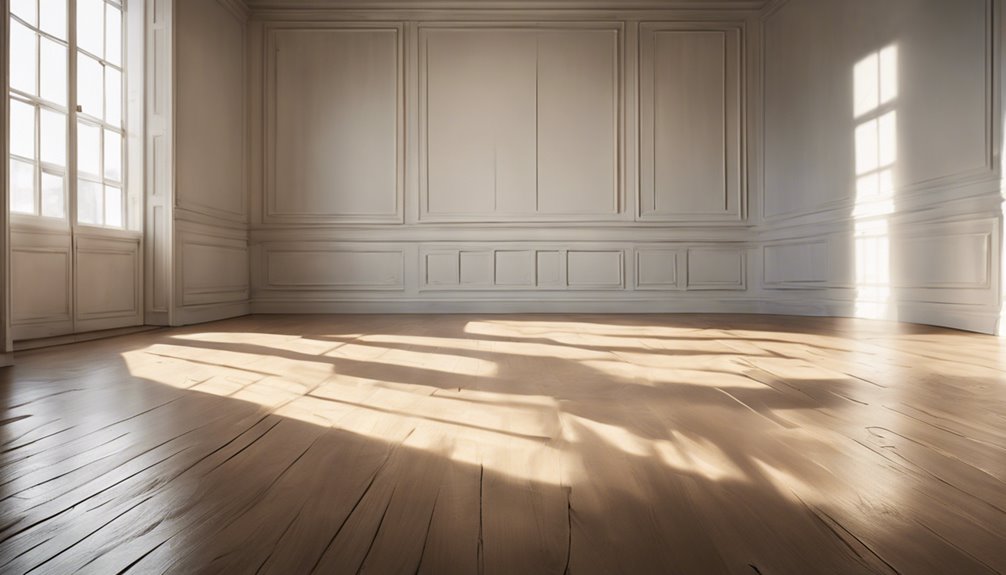
Before applying polish, you need to assess the condition of your floors to guarantee they're ready for treatment. Choosing the right polish is essential, as different finishes require different products. Always conduct a spot test in a discreet area to see how the polish interacts with your wood before committing to the entire surface.
Assessing Floor Condition
Evaluating the condition of your wood floors is essential before applying any polish. A thorough floor inspection and damage assessment will help you determine if your floors are ready for a rejuvenating polish. Look for the following signs:
- Scratches or dents that disrupt the surface
- Discoloration or fading in high-traffic areas
- Warping or buckling from moisture exposure
- Loose or damaged boards that need attention
Choosing the Right Polish
Once you've assessed the condition of your wood floors and determined they're ready for polishing, the next step involves selecting the right polish for the job. You'll need to decide between natural vs synthetic options. Natural polishes, often made from oils, enhance the wood's grain while providing a subtle sheen. Synthetic polishes, on the other hand, offer durability and a variety of gloss levels, from matte to high-gloss, giving you the freedom to choose the look that fits your style. Consider your lifestyle too; if you have pets or kids, a more resilient synthetic polish might be ideal. Remember, the right polish not only beautifies your floors but also protects them for years to come.
Conducting a Spot Test
To guarantee the polish you've chosen works well with your wood floors, it's important to conduct a spot test in an inconspicuous area. This step is vital as it allows you to observe how the polish interacts with your floor's finish. Here's what you should do:
- Select a small, hidden test area.
- Apply a small amount of polish using a clean cloth.
- Wait for the recommended drying time.
- Check for any discoloration or adverse reactions.
Applying the Polish
Applying the polish to your wood floors can transform their appearance, giving them a fresh, glossy finish that enhances their natural beauty. Start by choosing a polish that suits your floor type, ensuring it's compatible with your finish. Use a clean mop or applicator pad to apply the polish evenly. Follow the manufacturer's instructions for dilution, if necessary, and work in small sections to maintain control. Employ smooth, continuous strokes, using applying techniques like a figure-eight motion, which prevents streaking. Allow the polish to dry thoroughly before walking on the surface to avoid any damage. This careful polish application not only boosts the aesthetic but also adds a protective layer, helping your floors stay stunning for longer.
Buffing the Surface
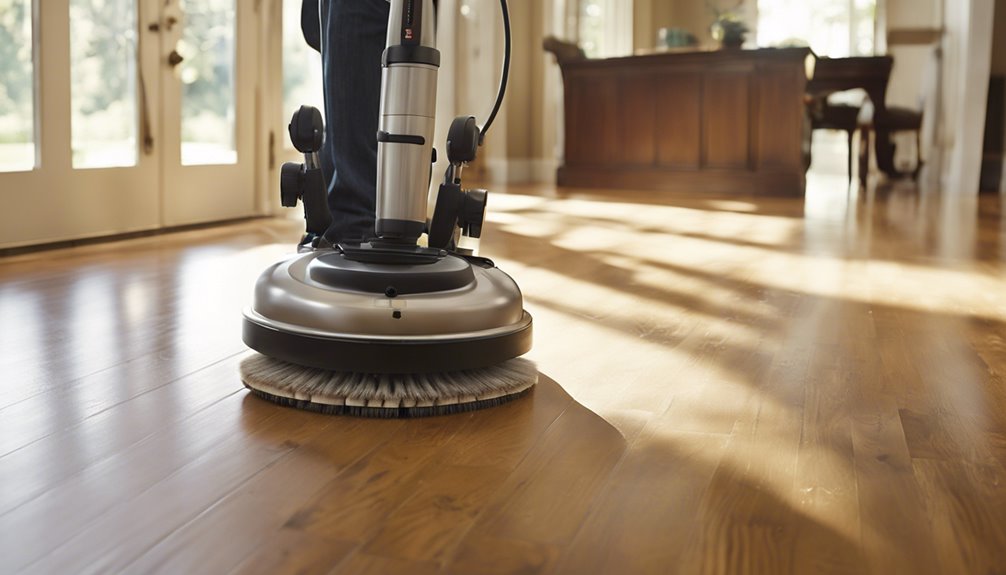
Buffing the surface of your wood floors is essential for achieving that high-gloss finish you desire. It enhances the polish you've applied and restores shine, making your floors look brand new. You'll want to take into account various buffing techniques and equipment options to find what works best for you. Here are some recommendations:
- Use a floor buffer or polisher for an even finish.
- Choose between a rotary or orbital buffer based on your floor type.
- Opt for a fine polishing pad to prevent scratches.
- Buff in sections to maintain control and guarantee thorough coverage.
Allowing for Drying Time
After you've buffed the surface of your wood floors to achieve that desired shine, the next significant step is allowing for adequate drying time. This guarantees that the polish sets properly, giving your floors a lasting finish. To maximize this process, consider using drying techniques such as increasing air circulation. Open windows or use fans to promote airflow. Additionally, maintaining ideal humidity levels in your home is vital; too much moisture can prolong drying, while too little can cause uneven results. Aim for humidity between 30-50% for the best outcomes. By allowing your wood floors to dry fully, you'll not only enhance their appearance but also protect them from damage, ensuring they stay beautiful for years to come.
Maintaining Your Floors
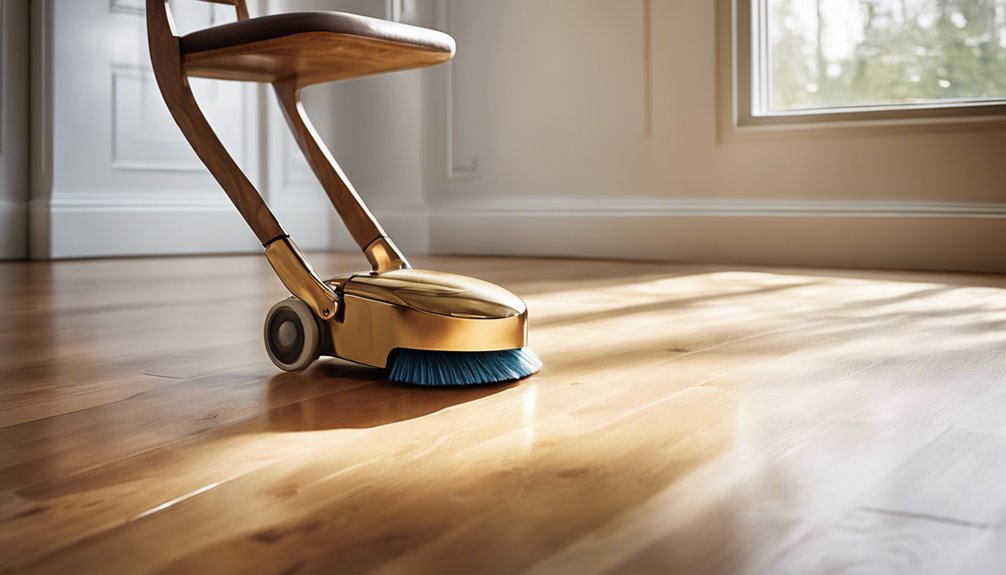
While your wood floors may look stunning after polishing, regular maintenance is essential to keep them that way. Implementing effective floor maintenance techniques can help you avoid common wood issues like scratches, discoloration, and warping. Here are a few tips to maintain your beautiful floors:
- Sweep or vacuum regularly to remove dirt and debris.
- Use a damp mop with a wood-safe cleaner to keep the surface fresh.
- Place mats at entryways to trap dirt and moisture before it reaches your floors.
- Address spills immediately to prevent water damage or staining.
Tips for Long-Lasting Shine
To keep your wood floors shining beautifully, establish a regular cleaning schedule to prevent dirt buildup. You'll also want to choose the right products specifically designed for wood surfaces, as using inappropriate cleaners can dull the finish. Finally, be mindful of moisture; excessive water can damage the wood and diminish its luster over time.
Regular Cleaning Schedule
Regularly maintaining your wood floors is essential for keeping them looking their best. Establishing a cleaning frequency that suits your lifestyle will help you create an effective maintenance routine. Aim for a mix of daily, weekly, and monthly tasks to guarantee longevity and shine.
- Daily: Sweep or vacuum to remove dust and dirt.
- Weekly: Mop with a damp cloth or a wood-safe cleaner.
- Monthly: Inspect for scratches or damage; touch up as needed.
- Seasonally: Deep clean and polish to enhance shine and protect the finish.
Use Appropriate Products
Choosing the right products for your wood floors can make all the difference in achieving a long-lasting shine. Opt for formulations specifically designed for wood, and always check for product safety. If you're keen on natural alternatives, consider using a mix of vinegar and water for a gentle clean.
| Product Type | Recommended Use |
|---|---|
| Commercial Polish | For periodic deep shines |
| Vinegar Solution | For regular cleaning |
| Beeswax or Oil | For enhancing natural luster |
Avoid Excessive Moisture
Maintaining the shine of your wood floors involves careful attention to moisture levels. Excessive moisture can lead to damage, warping, and a dull appearance. To prevent moisture damage and guarantee your floors stay vibrant, consider these practical tips:
- Use a dehumidifier in humid conditions to control humidity levels.
- Wipe up spills immediately to avoid prolonged exposure to water.
- Opt for a damp mop instead of soaking the floors during cleaning.
- Ensure proper ventilation in areas prone to moisture buildup, like kitchens and bathrooms.
Frequently Asked Questions
How Often Should I Polish My Wood Floors?
You should polish your wood floors every 3 to 6 months, depending on foot traffic and wear. Establishing a maintenance schedule can help keep your floors looking their best. If you've got pets or a busy household, you might need to polish more frequently. Always check for signs of dullness or scratches; these can indicate it's time for a touch-up. Following these frequency recommendations will guarantee your floors remain beautiful and protected.
Can I Use Furniture Polish on My Wood Floors?
Oh sure, why not? Just sprinkle some furniture polish on your wood floors and watch them shine—until they don't. In reality, furniture polish isn't meant for wood floors and could damage the finish. Instead, consider wood floor maintenance options like vinegar and water or specialized wood floor cleaners. These furniture polish alternatives will keep your floors looking great without the risk of buildup or harm, giving you the freedom to enjoy your space worry-free.
Is It Safe for Pets to Be Around Polished Floors?
You might be concerned about pet safety around polished floors. Generally, it's safe for pets, but you should verify the polish is non-toxic and specifically designed for floor maintenance. After applying polish, allow adequate drying time to prevent slips. Keep your pets off the floor until it's fully cured. Always check the product's label for any warnings. Taking these precautions can help you enjoy a beautiful floor while keeping your furry friends safe.
What Should I Do if the Polish Leaves Streaks?
If you notice streaks after polish application, don't worry; it's fixable! Start by using a microfiber cloth dampened with water to gently buff the streaked areas. This should help with streak removal. If that doesn't work, consider a vinegar and water solution — mix one part vinegar with three parts water. Apply it with a cloth and buff until the streaks disappear. Remember, gentle is key to avoid damaging your floor's finish!
Can I Polish Engineered Wood Floors?
Yes, you can polish engineered wood floors, but it's important to choose the right products to avoid damage. Look for a polish specifically designed for engineered wood, as these will maintain the floor's finish without causing build-up. Regular floor maintenance, like sweeping and mopping, is essential to keep your floors looking great. Just remember, too much polish can lead to streaks, so use it sparingly for that desired shine.

